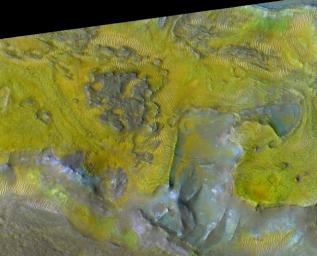
|
Carbonate-Olivine Relationship in Nile Fossae, Mars
- Click the image above for a larger view
- Full-Res JPEG (4222 x 3413) (2.9 MB)
- Full-Res TIFF (4222 x 3413) (43.2 MB)
Caption:
The color coding on this composite image of an area about 3 kilometers (2 miles) across on Mars is based on infrared spectral information interpreted as evidence of various minerals present. Carbonate (green) and olivine-bearing rocks (yellow) occupy the same level in the stratigraphy, and it is thought that the carbonate formed by involvement of water in altering olivine-bearing rocks.
The scene is eroded terrain in the Nili Fossae region of northern Mars. Beneath a rough-textured capping rock unit (purple) lie banded olivine-bearing layers (yellow), which in some places have been partially or wholly altered to carbonate (green). Beneath the olivine-and-carbonate unit are rocks with iron-magnesium smectite clays (light blue). Olivine is also found in sand dunes (near bottom right corner, for example), and it probably eroded from the nearby rocks.
The image overlays the color-coded spectral information from the Compact Reconnaissance Imaging Spectrometer for Mars (CRISM) onto a grayscale image from the High Resolution Imaging Science Experiment (HiRISE) camera. CRISM and HiRISE are two of the six science instruments on NASA's Mars Reconnaissance Orbiter.
The infrared spectral information comes from a CRISM image catalogued as FRT00003E12. The composite view here was made using 2.38-micrometer-wavelenghth data as red, 1.80 micrometer as green and 1.15 micrometer as blue.
The base black-and-white image is catalogued as PSP_002888_2025 by the HiRISE team.
Background Info:
NASA's Jet Propulsion Laboratory, a division of the California Institute of Technology, Pasadena, manages the Mars Reconnaissance Orbiter for the NASA Science Mission Directorate, Washington. Lockheed Martin Space Systems, Denver, is the prime contractor for the project and built the spacecraft. The Johns Hopkins University Applied Physics Laboratory led the effort to build the CRISM instrument and operates CRISM in coordination with an international team of researchers from universities, government and the private sector. The University of Arizona, Tucson, operates the HiRISE camera, which was built by Ball Aerospace & Technologies Corp., Boulder, Colo.
Cataloging Keywords:
| Name | Value | Additional Values |
|---|---|---|
| Target | Mars | |
| System | ||
| Target Type | Planet | |
| Mission | Mars Reconnaissance Orbiter (MRO) | |
| Instrument Host | Mars Reconnaissance Orbiter | |
| Host Type | Orbiter | |
| Instrument | Compact Reconnaissance Imaging Spectrometer for Mars (CRISM) | |
| Detector | ||
| Extra Keywords | Color, Dune, Infrared, Water | |
| Acquisition Date | ||
| Release Date | 2008-12-18 | |
| Date in Caption | ||
| Image Credit | NASA/JPL/JHUAPL/University of Arizona/Brown University | |
| Source | photojournal.jpl.nasa.gov/catalog/PIA11730 | |
| Identifier | PIA11730 | |
